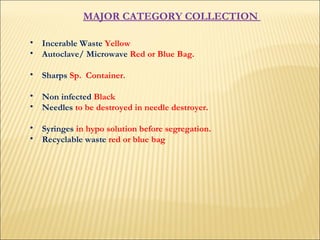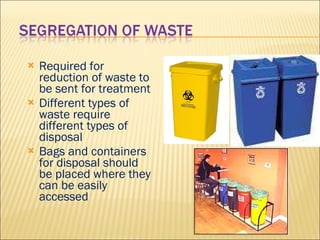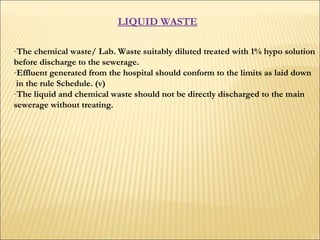BMW Management
- 1. HOSPITAL WASTE MANAGEMENT DR.N.C.DAS
- 2. BIO-MEDICAL WASTE B - Begin a System M - Make it Effective W - Work for its success
- 3. WHAT IS BMW ? Any waste which is generated during the process of diagnosis, treatment, research conducted for human beings and animals. BMW POLICY: BMW (Management & Handling) rule 1998 were notified under the Environmental Protection Act 1986 on 20 th July 1998. Every hospital to develop a comprehensive system for handling medical waste in terms of Segregation, transportation and disposal. A license has to be obtained from State Population Control Board so as to handle the infective waste.
- 4. OBJECTIVE OF BMW MANAGEMENT: - To minimize the production/ generation of infective waste. - Recycle the waste after treating to the extent possible. - Treat the waste by safe and environmentally acceptable methods. - Adequate care in handling to prevent HAI. - Safety precautions during handling the BMW.
- 5. MANAGEMENT PROCESS BMW PLANNING ORGANIZING IMPLEMENTING
- 6. PLANNING PLANNING CLASSIFICATION OF WASTE SAFETY OF STAFF TRAINING LOAD CO-ORDINATION CATEGORIZATION OF WASTE INFECTIVE WASTE LOAD STRATEGIC PLANNING MAN POWER EQUIPMENT DISPOSAL METHODS
- 7. CLASSIFICATION OF WASTE HOSPITAL WASTE INFECTIVE NON- INFECTIVE CONTAINING HUMAN OR ANIMAL TISSUE BLOOD & BLOOD PRODUCTS DRESSING MATERIALS SHARPS PLASTIC RECYCLE WASTE DRUG, CHEMICALS, RADIOACTIVE WASTE SOLID LIQUID CHEMICALS & REAGENTS EXCRETIONS, BODY FLUIDS - LABORATORY WASTE SOLID LIQUID KITCHEN NON-INFECTIVE MATERIALS WASHING DRINKING BATHING HORTICULTURE WATER
- 8. CATEGORIZATION OF INFECTIVE WASTE BMW CAT-1 HUMAN ANATOMICAL WASTE CAT-2 ANIMAL WASTE CAT-3 MICROBIOLOGY BIOTECHNOLOGY CAT-4 WASTE SHARP CAT-6 SOILED WASTE DRESSINGS, COTTON PLASTER CAT-5 DISCARDED MED. CYTOTOXIC DRUGS CAT-7 RECYCLABLE WASTE CAT-8 LIQUID WASTE CAT-9 INCINERATOR ASH CAT-10 CHEMICAL WASTE
- 9. TRAINING OF STAFF - All category staff must be trained to handle BMW . - Special training for transporters of Medical Waste & Safety Guidelines . - Accident Reporting - Maintenance of Records SAFETY GUIDELINES - Use of protective gowns, mask, gum boots. - Careful in handling sharps. - While shredding - Immunization for directly handling. - Asses the training load of various category . - Obtaining authorization for handling from SPCB - Annual Renewal of License. - Furnishing of Accident Reports if any. - Periodic Medical Check up Waste Handlers.
- 10. CO-ORDINATION HOSPITAL STATE POLUTION CONTROL BOARD COMMON FACILITY OWNER SHARING FACILITIES MCD NDMC BMW TRANSPORT AGENCY ENVIRONMENT ACTIVIST
- 11. ORGANIZING First and for most requirement is to constitute the BMW Management committee. MED. SUPDT. (CHAIRMAN ) All HODs (MEMBERS) OFFICER I/C BMW (MEMBER SEC.) N. SUPDT. SISTER I/C WARDS N.O OFFICER I/C INFECTION CONTROL I/C SANITATION SANT. SUPDT. SANITATION STAFF
- 12. FUNCTIONS Ensuring implementation of BMW guidelines in the hospital. Co-ordination with various agency. Investigation of all accidents in handling waste. Rendering training to officers & staff. Ensuring immunization & safety guidelines. Procurement, functioning and maintenance of various equipments, incinerator, autoclave, microwave and shredder. Monitoring of segregation, transportation and disposal. 8. Record keeping and reporting to SPCB.
- 13. IMPLEMENTATION BMW HANDLING & MANAGEMENT SEGGREGATION TRANSPORTATION DISPOSAL
- 14. SEGGREGATION COLLECTION LABELLING HOLDING SEGGREGATION CAN BE DIVIDED INTO THREE PARTS : The segregation to be done at the site of generation. The responsibility of proper segregation lies with the generator of BMW. Segregation to be done as per category strictly as per BMW rule.
- 15. COLLECTION OF BMW No. CATEGORY TYPE OF CONTAINER COLOUR CODING DISPOSAL METHOD 1. HUMAN ANATOMICAL WASTE PLASTIC BAG YELLOW INCINERATOR 2. ANIMAL WASTE PLASTIC BAG YELLOW INCINERATOR 3. MICROBIOLOGY & BIO-TECHNOLOGY WASTE PLASTIC BAG YELLOW/ RED AUTOCLAVE/ INCINERATOR/ MOCROWAVE 4. WASTE SHARP PLASTIC BAG, PUNCTURE PROOF CONTAINER BLUE/ WHITE/ TRANSLUCENT DEEP BURIAL 5. DISCARDED MEDICINES & CYTOTOXIC WASTE PLASTIC BAG BLACK DEEP BURIAL 6. SOLID WASTE (SOILED) PLASTIC BAG YELLOW/ RED INCINERATOR/ ATUOCLAVE 7. SOLID WASTE ((RECYCABLE PLASTIC) PLASTIC BAG BLUE/ WHITE AUTOCLAVE/ MICROWAVE 8. LIQUID WASTE ------------- -------------- SWEARAGE AFTER TREATMENT 9. INCINERATOR ASH PLASTIC BAG BLACK DEEP BURIAL 10. CHEMICAL WASTE (SOLID) PLASTIC BAG BLACK DEEP BURIAL
- 16. MAJOR CATEGORY COLLECTION Incerable Waste Yellow Autoclave/ Microwave Red or Blue Bag. Sharps Sp. Container. Non infected Black Needles to be destroyed in needle destroyer. Syringes in hypo solution before segregation. Recyclable waste red or blue bag
- 17. Required for reduction of waste to be sent for treatment Different types of waste require different types of disposal Bags and containers for disposal should be placed where they can be easily accessed
- 18. LABELLING All the bags when filled up to ¾ should be removed tied and labeled. (Type of waste, site of generation) 2. All bags must be Bio- degradable having the Bio- hazzard signs. HOLDING Temporary storage or holding of the bags for a certain period of time before it is transported. No. untreated waste be kept stored beyond a period of 48 hours. It should be ensured that waste bags are not torn up by dogs and other animals. The category of waste which require pre- treatment should be treated at the site of generation in hypo solution before discarding. The quantity of waste generated should be kept in record by the generator.
- 19. TRANSPORTATION Within the hospital BMW transportation route to be designated to avoid patient care areas. There should be separate and fixed time schedule for collection of infected and non- infected waste. To avoid holding at least the waste should be collected twice a day. Dedicated wheeled containers, trolleys or carts with cover and with proper labeling to be used for transportation. In the event of any spillage the carts should be properly disinfected and washed. All the transporters needs to be immunized and take safety measures to avoid accident. STORAGE There should be provision of over night storage for the infected waste. It should be protected from animals and rig pickers. Proper recording of waste collection from various areas of the hospital. The area of storage should be covered and grilled from all sides.
- 20. DISPOSAL OF HOSPITAL WASTE DISPOSAL WITHIN THE HOSPITAL OUTSIDE THE HOSPITAL GENERAL WASTE: Through Dalao MCD/ NDMC INFECTED WASTE: Through incinerator/ autoclave/ microwave and shredder/ deep burial. as per available facility. Through licensed transporters. With special BMW transport vehicles.
- 21. MANAGEMENT OF INCINERATOR / AUTOCLAVE Monitoring of incinerator/ autoclave/ microwave shall be carried out once in a month to check the performance of the equipment. The proper operation & Maintenance of the incinerator/ autoclave/ microwave. Attainment of prescribed temperatures in both the chambers of incinerator while incinerating the waste. Not to incinerate PVC plastic materials. Only skilled persons operate the equipment. Proper record book shall be maintained for the incinerator/ autoclave/ microwave/ shredder. Such record book shall have the entries of period of operation, temperature/ pressure attained while treating the waste, quantity of waste treated etc. The scavengers shall not be allowed to sort out the waste. Proper hygiene shall be maintained at, both, the waste treatment plant site as well as the waste storage area. Waste sharp, plastic waste, chemical and liquid waste to be treated with chemical disinfectant like1% hypochlorite solution or any other equivalent chemical reagent to ensure disinfection.
- 22. LIQUID WASTE The chemical waste/ Lab. Waste suitably diluted treated with 1% hypo solution before discharge to the sewerage. Effluent generated from the hospital should conform to the limits as laid down in the rule Schedule. (v) The liquid and chemical waste should not be directly discharged to the main sewerage without treating.
- 23. Nosocomial infections Injuries from sharps Risk of infection of waste handlers, scavengers Recycling of used syringes and other disposable items. Health hazards of poor waste management-
- 24. Hospital Administration Made Easy http//hospiad.blogspot.com An effort solely to help students and aspirants in their attempt to become a successful Hospital Administrator. hospi ad DR. N. C. DAS
























